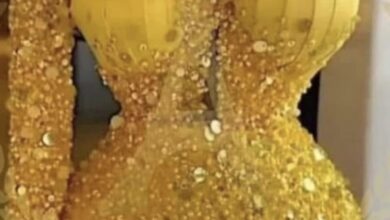Rania Hilal's jewelry is all about lending a modern, international touch to handmade designs with a distinctly Egyptian flavor. In this way, she aims to help revolutionize Egypt’s jewelry industry, boosting its ability to compete globally.
“Egyptian designers should apply the country’s culture to jewelry designs in a way that fits with our modern life," says Hilal. "There are thousands of designers from around the world inspired by our culture, so it’s time to produce what represents our Egyptian identity and export it to the global market.”
What largely distinguishes the collection are the techniques she applies, twisting multiple strands of wires in oriental styles, embellished with semi-precious stones, pearls, crystals and acrylic beads.
“All my collections are handmade, crafted without using welding, because I produce the accessories at home. So, when I started my business, I was looking for the simplest way to avoid a complicated process,” she says.
The method, however, is time-consuming; sculpting one piece takes more than six hours.
“I never copy or sketch out a design. I prefer to unleash my imagination while twisting the wire, and automatically the design starts to take a unique shape of its own,” she says.
When creating a new collection, Hilal aims to introduce a variety of styles in an effort to satisfy all tastes, which tend to vary depending on age.
“Young women often go for vivid colors, bold styles, such as big earrings and long chains that can be worn with casual wear, giving a chic and simple look.”
Older women, meanwhile, prefer orange agate as well as Y-style pendants the most.
Hilal’s innovative touch has not only emerged from her innate artistic talent. She studied applied arts at the university and took an intensive training course in wire jewelry design, which helped her to become acquainted with the basic theories of sculpting accessories.
In June 2010, Hilal’s career witnessed a turning point after she presented her collection at an exhibition at the Gezira Art Center, which for the first time provided a special section for jewelry.
“I used to display my work at ‘open days’ [mini-bazaars hosted in someone's home], but this was my first experience of joining an exhibition. I am so proud that sculpting jewelry is now seen from a new perspective in our country, because it is not merely about accessories — it is artistic form that deserves to be appreciated like any other aesthetic piece.”
The Gezira Art Center was just the start. In the same year, Hilal participated in more exhibitions, including a spot in the young designers' Pavillion at Furnex 2010, and her pieces were chosen by the Ministry of Trade and Industry to be shown at the prestigious Maison et Objet exhibition in Paris.
“My artistic taste was developed considerably through taking part in exhibitions, where most of the attendees have an artistic sense and provide constructive feedback that supports me in my professional growth,” Hilal says.
Hilal first began jewelry-making as a casual pastime, while working as a designer for the Ministry of Trade and Industry. Later, once she'd proven herself in the jewelry design field, this pastime became a part-time business with serious potential.
“It is very challenging to change an artistic project into a business venture. Expanding a small business to a large scale of production requires a background of the principals of running a business.
"The government should raise awareness about how to start your own business and provide financial support for micro-enterprises, especially since we already have the Jewelry Technology Center, an organization that reinforces the development of these projects,” she concludes.
Hilal’s new collection can be found at the Gezira Art Center in Zamalek until 2 May, or you can order from her Facebook group at prices ranging from LE100 to LE400.
Facebook: Rania Hilal Designs
Website: www.raniahilaldesigns.com
Email: [email protected]
Gezira Art Center address: 1 Al-Masrafy Streeet, near Cairo Marriott hotel




